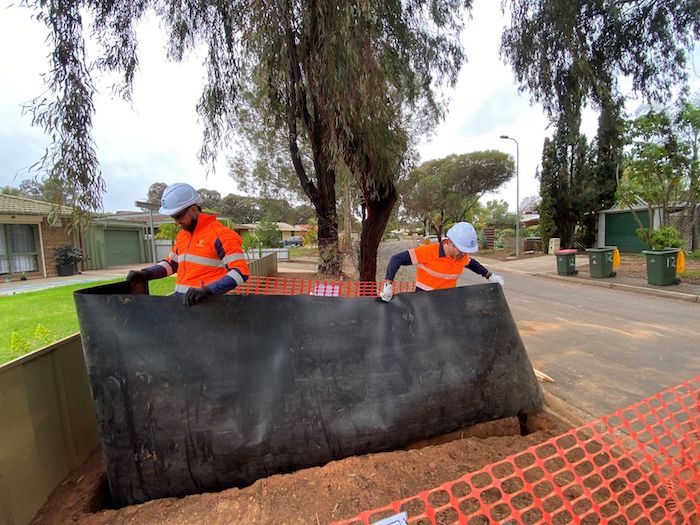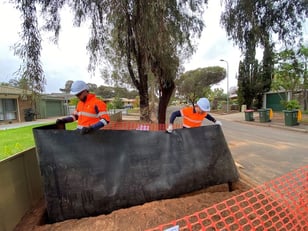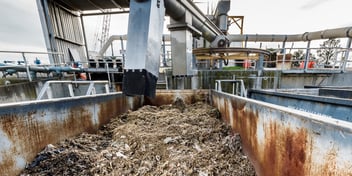SA Water trialling plastic liners to reduce sewer blockages

In a bid to reduce customer sewer blockages resulting from intrusive tree roots, SA Water has begun a trial across metropolitan Adelaide involving the installation of plastic liners below ground between problematic trees and sewer connections.
As part of stage one of the pilot, a thin layer of high-density plastic liner made from 100% reused material has been installed below ground at four customer properties that have experienced higher than usual sewer blockages caused by tree root intrusion.
SA Water Innovation Specialist Alex Czura said the liners aim to restrict roots moving towards sewer pipes, without impacting the tree’s health.
“Tree root intrusion is the leading cause of blockages at customer’s sewer connection points, and when caught up with cooking fats, oils and other foreign objects flushed down the toilet or sink, can lead to everything that goes down coming back up,” Czura said.
“Most sewer blockages can be cleared by cleaning the inside of the pipe, without the need for any excavation. However, in some cases, tree roots continue to grow, making it difficult to prevent further blockages occurring at the same location.”
 Made from 100 per cent re-used materials, the barrier keeps thirsty roots at bay while protecting sewer pipes.
Made from 100 per cent re-used materials, the barrier keeps thirsty roots at bay while protecting sewer pipes.
Digging a barrier around the base of a tree using hydro-vac excavation and a root sawing method, the utility hopes to prevent root growth towards nearby sewer connections, Czura said.
“With the dig needed to install the barrier just 150 millimetres wide, the end result also reduces the need to excavate large areas of kerbing, footpath and residential driveways, often required for replacing damaged customer connections,” he said.
“This project represents our proactive approach to protecting pipes and customer connections, rather than reactively managing an incident after it’s occurred.”
Liners stop tree roots from entering sewers
During the three-year trial, SA Water will use CCTV to monitor wastewater pipes at regular intervals, helping to assess the viability of the root barrier technology and if it is suitable for other problem areas around South Australia.
“While it’s early days, initial works show the installation of root barrier technology comes in at just one-third the cost of a traditional wastewater connection replacement, and takes less than a quarter of the time,” Czura said.
“This may allow us to improve sewer services for three times as many properties, for the same cost.”
Czura said the project will also involve working with local councils and landscape architects to provide expertise on the most suitable trees and plants to grow near water and wastewater networks.
“[This will] support tree canopy coverage for greening and cooling, while also protecting our underground infrastructure,” he said.
“This is an exciting initiative that can help us save time and money while continuing to deliver the safe and reliable wastewater services that our customers expect.”


